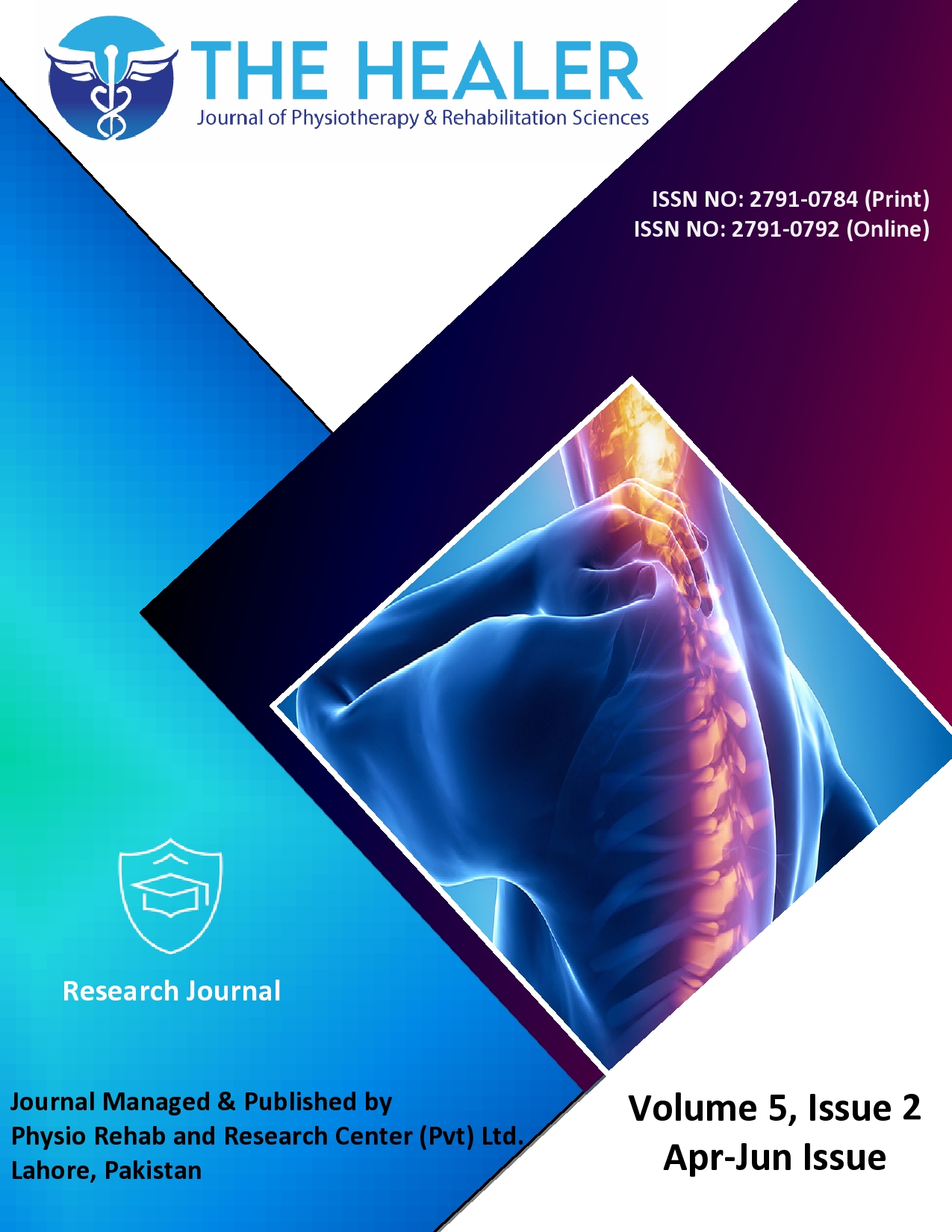Prevalence of Plantar Fasciitis and Non-Specific Chronic Low Back Pain and Its Association with Body Mass Index among Teachers of Private Schools in Peshawar
DOI:
https://doi.org/10.55735/yp1qw409Keywords:
Body mass index , Chronic low back pain , Musculoskeletal disorders , Plantar fasciitis , Prolong standingAbstract
Background: Plantar fasciitis and non-specific chronic low back pain are common musculoskeletal disorders in professions involving prolonged standing, such as teaching. Teachers often experience prolonged standing. Poor ergonomics and elevated stress levels may contribute to the development of these conditions. Objective: To evaluate the prevalence of plantar fasciitis and non-specific chronic low back pain in private school teachers and assess the association of body mass index with these conditions. Methodology: A cross-sectional study was conducted among 383 private school teachers in Peshawar using a cluster sampling technique. Ethical approval was obtained from the departmental research committee of City University of Science and Information Technology, and informed consent was obtained from all participants. Teachers aged 25 to 40 years with at least six months of teaching experience were included, while administrative staff, pregnant females, and foot deformities or traumatic low back pain were excluded. The Windlass test was used to diagnose plantar fasciitis, and the numerical pain rating scale was used to assess pain severity. Body mass index was calculated and categorised according to WHO criteria. Data were analysed using SPSS version 27 with descriptive statistics and chi-square tests to evaluate the association of BMI with plantar fasciitis and non-specific chronic low back pain. Results: Among 383 participants, 73.9% were female and 26.1% male. The prevalence of chronic low back pain was 60.1%, while plantar fasciitis was 65.5%. Mild pain was the most reported severity for both conditions. Body mass index showed no statistically significant association with NSCLBP or plantar fasciitis. However, a significant linear trend (p=0.034) was observed for body mass index and chronic low back pain. Conclusion: A High prevalence of plantar fasciitis and chronic low back pain was observed among teachers. Although body mass index was not significantly associated, the linear trend highlights the need for ergonomic and weight management interventions. These findings highlight the importance of ergonomic interventions, regular screening, and weight management programs to prevent musculoskeletal disorders in teachers and improve their occupational health.
Downloads
References
1. Sikander DMS, Shinwari NU, Shah DJ, et al. Prevalence and Association of Risk Factors for Plantar Fasciitis Among Nurses in Government Tertiary Care Hospitals of Peshawar. Journal of Health and Rehabilitation Research 2024; 4(2); 1623-1628. DOI: https://doi.org/10.61919/jhrr.v4i2.1157
https://doi.org/10.61919/jhrr.v4i2.1157 DOI: https://doi.org/10.61919/jhrr.v4i2.1157
2. Khan Y, Khan A, Iqbal M, Shah D, Ahmad F. Prevalence of Plantar fasciitis in academic physical therapists of KMU-affiliated Institutes and clinical physical therapists in tertiary care hospitals: A cross-sectional study. National Journal of Life and Health Sciences 2023; 2(1): 27-30. DOI: https://doi.org/10.62746/njlhs.v2n1.15
https://doi.org/10.62746/njlhs.v2n1.15 DOI: https://doi.org/10.62746/njlhs.v2n1.15
3. Ujala M, Ayman F, Esha A, Syeda Zainab T, Iqra T, Anam R. Prevalence of Plantar Fasciitis Pain and Its Association with Quality of Work Among Sales Promotion Persons at Supermarkets: Prevalence of Plantar Fasciitis and Work Quality. Journal of Health and Rehabilitation Research 2024; 4(3): 1-4. DOI: https://doi.org/10.61919/jhrr.v4i3.1543
https://doi.org/10.61919/jhrr.v4i3.1543 DOI: https://doi.org/10.61919/jhrr.v4i3.1543
4. Lee W, Metgud N, Moore M. Association of Obesity and Plantar Fasciitis in Patients With Plantar Heel Spurs. Foot & Ankle Orthopaedics 2023; 8(4): 24730114231213625. DOI: https://doi.org/10.1177/24730114231213625
https://doi.org/10.1177/24730114231213625 DOI: https://doi.org/10.1177/24730114231213625
5. Alharbi Z, Albalawi M, Alotaibi S, et al. Prevalence and risk factors of plantar fasciitis amongst the population of Al Jouf region: a cross-sectional study. International Journal of Medicine in Developing Countries 2024; 8(2): 628-632. DOI: https://doi.org/10.24911/IJMDC.51-1702452942
https://doi.org/10.24911/IJMDC.51-1702452942 DOI: https://doi.org/10.24911/IJMDC.51-1702452942
6. Raza A, Saleem S, Saeed H, Arif AB, Zafar Z, Ali Z. Incidence of plantar fasciitis in overweight patients of government hospitals of Faisalabad city. The Professional Medical Journal 2021; 28(5): 718-24. DOI: https://doi.org/10.29309/TPMJ/2021.28.05.6271
https://doi.org/10.29309/TPMJ/2021.28.05.6271 DOI: https://doi.org/10.29309/TPMJ/2021.28.05.6271
7. Siddiqui AS, Javed S, Abbasi S, Baig T, Afshan G. Association Between Low Back Pain and Body Mass Index in Pakistani Population: Analysis of the Software Bank Data. Cureus 2022; 14(3): e23645. DOI: https://doi.org/10.7759/cureus.23645
https://doi.org/10.7759/cureus.23645 DOI: https://doi.org/10.7759/cureus.23645
8. Hlaing SS, Puntumetakul R, Khine EE, Boucaut R. Effects of core stabilization exercise and strengthening exercise on proprioception, balance, muscle thickness and pain related outcomes in patients with subacute nonspecific low back pain: a randomized controlled trial. BMC Musculoskeletal Disorders 2021; 22(1): 998. DOI: https://doi.org/10.1186/s12891-021-04858-6
https://doi.org/10.1186/s12891-021-04858-6 DOI: https://doi.org/10.1186/s12891-021-04858-6
9. Šagát P, Bartík P, Prieto González P, Tohănean DI, Knjaz D. Impact of COVID-19Quarantine on Low Back Pain Intensity, Prevalence, and Associated Risk Factors among Adult Citizens Residing in Riyadh (Saudi Arabia): A Cross-Sectional Study. International Journal of Environmental Research and Public Health 2020; 17(19): 7302. DOI: https://doi.org/10.3390/ijerph17197302
https://doi.org/10.3390/ijerph17197302 DOI: https://doi.org/10.3390/ijerph17197302
10. Járomi M, Szilágyi B, Velényi A, et al. Assessment of health-related quality of life and patient’s knowledge in chronic non-specific low back pain. BMC Public Health 2021; 21(1): 1479. DOI: https://doi.org/10.1186/s12889-020-09506-7
https://doi.org/10.1186/s12889-020-09506-7 DOI: https://doi.org/10.1186/s12889-020-09506-7
11. de Souza JM, Pinto RZ, Tebar WR, et al. Association of musculoskeletal pain with poor sleep quality in public school teachers. WORK 2020; 65(3): 599-606. DOI: https://doi.org/10.3233/WOR-203114
https://doi.org/10.3233/WOR-203114 DOI: https://doi.org/10.3233/WOR-203114
12. Islam M, Monni A, Islam S, Rahman M, Alauddin M, Sharif R. Prevalence of Disability in Chronic Non-
Specific Low Back Pain Patients. Saudi Journal of Medical and Pharmaceutical Sciences 2024; 10(4): 256-60. DOI: https://doi.org/10.36348/sjmps.2024.v10i04.008
https://doi.org/10.36348/sjmps.2024.v10i04.008 DOI: https://doi.org/10.36348/sjmps.2024.v10i04.008
13. Ghaffar T, Sultan S, Khalid A, et al. Association of Low Back Pain with Body Mass Index and Stress Among House Officers in Different Rotational Placements: Association of LBP with BMI and Stress. The Therapist 2023; 4(1): 52-56. DOI: https://doi.org/10.54393/tt.v4i1.114
https://doi.org/10.54393/tt.v4i1.114 DOI: https://doi.org/10.54393/tt.v4i1.114
14. Bhoir K, Vardhan G.D V. Prevalence of Plantar Fasciitis Among Nurses at A Tertiary Care Centre in A Rural Area: A Cross Sectional Study. International Journal of Physiotherapy and Research 2021; 9(4): 3900-3906. DOI: https://doi.org/10.16965/ijpr.2021.140
https://doi.org/10.16965/ijpr.2021.140 DOI: https://doi.org/10.16965/ijpr.2021.140
15. Nikam H, Kanhere A, Ghodey S. Prevalence of plantar fasciitis in traffic police officers: a cross sectional study. International journal of scientific research 2020; 9(12)
https://doi.org/10.36106/ijsr DOI: https://doi.org/10.36106/ijsr
16. Hashmi R, Naeem L, Arif S, Habiba U, Irfan R, Zafar M. Frequency of plantar fasciitis among females in teaching profession. Journal of Aziz Fatimah Medical & Dental College 2021; 2(2): 53-7. DOI: https://doi.org/10.55279/jafmdc.v2i2.102
https://doi.org/10.55279/jafmdc.v2i2.102 DOI: https://doi.org/10.55279/jafmdc.v2i2.102
17. Alwashmi AH. Prevalence of Low Back Pain and Associated Factors Among Qassim University Medical Students: A Cross-Sectional Study. Cureus 2023; 15(9): e44596. DOI: https://doi.org/10.7759/cureus.44596
https://doi.org/10.7759/cureus.44596 DOI: https://doi.org/10.7759/cureus.44596
18. Vilas S, Salunkhe P. Prevalence of Low Back Pain in Plantar Fasciitis Patients. Journal of Ecophysiology and Occupational Health 2024: 24(2): 191-7. DOI: https://doi.org/10.18311/jeoh/2024/36404
https://doi.org/10.18311/jeoh/2024/36404 DOI: https://doi.org/10.18311/jeoh/2024/36404
19. Kousar A, Islam F, Gulzar K. Prevalence of Plantar Fasciitis and Contributing Factors in Patients Visiting Physical Therapy Center of Secondary Care Hospital. NeuroQuantology 2023; 21(6): 1808-1820.

Downloads
Published
License
Copyright (c) 2025 The Healer Journal of Physiotherapy and Rehabilitation Sciences

This work is licensed under a Creative Commons Attribution 4.0 International License.














